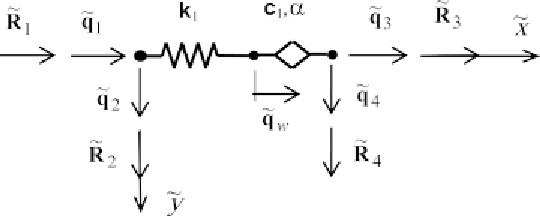Geology Reference
In-Depth Information
Figure 6. A schematic of the fractional derivative Maxwell model
dampers, while the matrices
C
s
( )
,
K
s
( )
and the (
p
( )
t
=
represent
the effect of the coupling of dampers with the
structure. The (
r
×
) matrices
C
dd
and
K
dd
de-
scribe the damping and stiffness properties of
dampers with braces, respectively. Moreover,
q
s
( )
,
q
d
( )
and
p
s
( )
are the global vectors of
nodal generalized displacements, internal vari-
ables and nodal excitation forces, respectively.
The concept of proportional damping is used to
model the damping properties of the structure,
i.e.:
C
T
n
×
) matrices
C C
sd
=
,
K K
sd
s
( )
t
=
0
0
(23)
ds
ds
If the structure with VE dampers modelled
using the simple Maxwell model is considered,
then all of the relationships presented above are
valid, provided that the appropriate matrices given
in Appendix A are used to generate the global
matrices appearing in Equations (20) and (21).
In the case of the structure with dampers mod-
elled by the simple Kelvin model, the equation of
motion (20) takes the form:
( )
s
( )
s
=
α
M
+
κ
K
where
α
and
κ
are
ss
ss
ss
proportionality factors.
The equation of motion, written in terms of
state variables, will also be useful. After introduc-
ing the following state vector
x
M q
( )
t
+
(
C
+
C
)
q
( )
t
ss
s
ss
dd
s
+
(
K
+
K q
)
( )
t
=
p
( )
t
(24)
T
( )
t
=
[
( ),
t
( ),
t
( )]
t
the following state
q
q
q
ss
dd
s
s
s
s
d
equation could be written
because internal variables do not exist.
The matrices
C
dd
and
K
dd
appearing in (24)
are built from the matrices
C
d
and
K
d
given by
Equation (A.12). The state equation has the form
of Equation (20) where now
Ax
( )
t
+
Bx
t t
=
s
(22)
( )
( )
where
C M C
M 0
( )
( )
t
t
ss
ss
sd
q
q
s
( )
t
=
,
A
=
0
,
x
ss
s
C
0
C
ds
dd
C
+
C M
M
ss
dd
ss
A
=
,
K
0
K
0
ss
sd
ss
B
=
0
−
M 0
,
ss
K
0
K
ds
dd

Search WWH ::

Custom Search